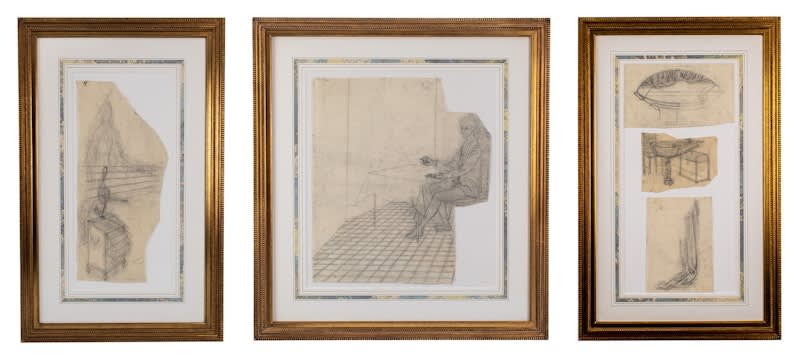By Irene Lyla Lee
29 May 2024
A Visionary Line: Remedios Varo Drawings is the first presentation of the artist’s work in New York in nearly forty years, following a major retrospective at the Art Institute of Chicago in 2023. It also represents the first exhibition solely devoted to Remedios Varo’s drawings. Through nine works comprising developmental sketches, a cartoon, tracing images, and one standalone drawing, A Visionary Line underscores how drawing anchored this masterful, rigorously innovative artist’s practice. Varo’s pre-planned drawings allowed her to experiment freely on the canvas, and to conjure the fusion of spiritual, scientific, and artistic worlds that her work is known for.
Presented by Gallery Wendi Norris at Adler Beatty, the exhibition’s library-like space encourages close looking. The drawings on view each helpfully demonstrate the range of drafting techniques that Varo used, showing the various ways that she controlled her process and instilled a sense of order, precision, and solidity into her work. The works unmistakably bear the same precise yet subtle quality of line as her paintings, unsurprising as she often traced her drawings directly onto the canvas. Five studies for the painting Armonía [Harmony] (1956) show how Varo used tracing and drawing to ground her formally and narratively complex works. Individual sketches of a wall niche, a wash basin, drapery, a chest of drawers, and the central figure unveil her development of these detailed areas of the composition. In the finished painting, in spite of this work’s clarity of line and proportion, however, a more magical narrative undermines the seemingly stolid principles of gravity and science.
Varo learned how to draw like an architect from her father, an engineer, who exposed her to works by the Italian and Northern European Renaissance masters, among other objects. A study for the painting Nacer de nuevo [To Be Reborn] (1960) contains a grid overlaid on top of a woman’s nude torso, demonstrating Varo’s use of another traditional drawing method in order to control her process. High contrast shadows and an arrested-in-motion pose characterize the figure, adding to its complexity. In order to reproduce these aspects in the painting, Varo would likely have used the grid to carefully transpose or enlarge the figure, square-by-square, onto the canvas. The work’s themes of illumination, discovery, and new beginnings contrast with the stillness and geometric quality of the lines in the painting, and the laborious process of the work’s making. The painting made from the drawing features a female figure whose body erupts from the walls of an inner red chamber. She peers forward to examine a swirling, moonlit potion on a wooden table, referencing the theme of a revelation or rebirth, as indicated in the title.
Varo believed in a universal organization of the visible and invisible realms, which could affect physical objects in the world. When she was living in Mexico, she made potions and practiced alchemy and tarot with fellow artists Leonora Carrington and Kati Horna, eliding distinctions between science, art, music, alchemy, spirituality and the occult, which coexist harmoniously in her work. She followed the work of physicists who were her contemporaries in her time, and would likely have been aware that many great scientific discoveries are, in effect, accidents.
In a study for the painting El flautista (1955), Varo relies on traditional drafting methods as a foil to her formal experimentation. This study of a structural plan for a tower is sketched on three taped-together sheets of paper where Varo rigorously worked out the sense of perspective of the octagonal building. The fragment of paper only shows the tower’s left side, as it seems the right was cut out from the larger drawing. In the painting itself, the incision line divides the edifice in half, marking different painting methods and indicating real and imagined sides of the tower. Varo may have even used the drawing as a stencil directly on the canvas to map out each side. On the right, she renders the building with smooth, stacked-stone walls made of fossils, while the left side is turned completely inside out, revealing its inner architecture by scratching onto the painting’s surface and into the white gesso underneath, a process known as sgraffito. It shimmers through a white mist and dark clouds, which she created by scumbling and blowing thinned paint. The tower looks more structurally precise, but less palpably real.
In her painting El flautista, a musician’s song lifts the fossilized rocks from the ground onto the tower, in an example of how something immaterial—music—can manifest change in the tangible world to reverse the laws of time and physics. This reversal operates similarly in Varo’s work. Her meticulous drawing practice, where she planned, developed architectural space and shading, or worked through her mistakes, allowed her to subsequently scrape, scumble, spray, and smear on the canvas. She imbued her paintings with fantastical themes and creatures whose supernatural spells defy the orderly principles that underpin her work. By inducing the chance for things to “go wrong” on the canvas, she approximates the process of the scientist, the mystic, or the alchemist with that of the artist herself.





